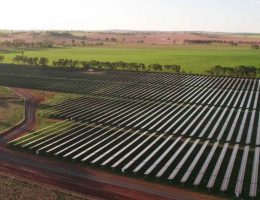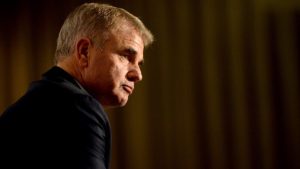Australia’s coal and gas lobby has come out all guns blazing against the New South Wales government’s renewable energy transition plan, threatening legal action and an investment strike that could lead to higher prices and raise fears of a supply shortage.
The extraordinary attacks came from three of the country’s most powerful coal generation incumbents, their principal lobby group, conservatives and – inevitably – the federal energy and emissions reduction minister Angus Taylor.
Trevor St Baker, the influential owner of th ageing Vales Point coal generator in NSW, led the charge, threatening legal action over what he describes as the “gross intervention” in the market by the NSW government plan to create three renewable energy zones and usher in $32 billion of new renewable energy and storage.
St Baker, a Liberal Party donor who has benefited enormously after buying the Vales Point generator from the state government for a peppercorn price of just $1 million, said the NSW policy was a massive intervention (that did not favour his business) and fossil fuel companies could seek “legal address” in the courts.
His comments were supported by the country’s two biggest private operators of coal generation in Australia, AGL (also the biggest polluter in the country) and EnergyAustralia, who threatened to put possible battery storage and fast-response gas plant investments on hold unless the state government backs away from its plan.
This prompted more political intervention, with One Nation’s Mark Latham threatening to derail the legislation in parliament with a series of several hundred amendments, and Taylor – possibly the most interventionist energy minister ever – also complaining, and questioning the NSW modelling.
Frustrating as it is, the pushback by the incumbent fossil fuel generators and their representatives is not surprising. The Australian Energy Market Operator’s 20-year blueprint – known as the Integrated System Plan – designed to negotiate the inevitable retirement of Australia’s ageing coal fleet, says Australia faces the fastest transition to renewables in the world.
And at the heart of this is NSW, the state with the country’s biggest grid and the highest dependence on coal, and which has possibly done the least to date of any state to address that problem, despite facing the closure of four of its five big coal generators over the next 15 years.
But it now – like the other states – it has a plan, championed by the state Liberal government’s energy and environment minister Matt Kean, and widely applauded by analysts and investors.
In a nutshell, the plan is to create at least three renewable energy zones and encourage 12GW of new wind and solar capacity beyond what would have been built in “business as usual”, as well as 2GW of long term storage.
It’s needed because the federal government has no policy at all, apart from a general wish to see coal stay open, more gas burned, and to duck its responsibility to set long term targets or any sort of strategy. And NSW is now attacked by the incumbents because it is a plan, which threatens both their profits and their domination over the market.
AEMO CEO Audrey Zibelman, in one of her last public appearances before taking on a new role at X – the “moonshot” technology company created by Google – vented her frustration by saying Australian companies needed to stop whingeing about energy policies, and get on with the transition..
Kean was more direct. “We want more competition and lower prices and the people complaining about this are the ones that don’t want competition in the market,” he said on Monday at the AFR energy and climate summit.
“They don’t want lower prices because they want to continue to make super profit at the expenss of the families of NSW.”
Those observations speak of a looming showdown between the states and big energy, and are borne out of experience. The incumbent fossil fuel industry has fought every major policy initiative of the last decade and more — from carbon pricing, to renewable energy targets, to rooftop solar installations, to energy efficiency, demand management, and even the change to five minute settlements – an initiative put forward by the zinc refiner Sun Metals, which was tired of being ripped off by the generators and which now plans to go 100 per cent renewables.
State energy ministers also also aware of the way the market failed to respond to the closure of the Northern and Playford coal generators in South Australia, to the threat of load shedding in that same state in early 2017, and the closure of Hazelwood in Victoria. As Kean says, they were more interested in cashing in on super profits.
It’s why the South Australia state government intervened in its market, most notably for the installation of the Tesla big battery at Hornsdale; it’s why the Victoria has done the same with it reverse auctions for renewables and its choice of the 300MW Victoria big battery to upgrade the capacity of its main link to NSW; and it’s why the NSW government has sought to take control of its energy future through the creation of at least three REZs and a long term underwriting agreements for low cost bulk wind and solar power and long term storage.
Queensland has also intervened to instruct its state owned generators to stop their predatory pricing practices, and has now created a new state owned utility, CleanCo, that is writing major renewable contracts and pushing its coal-dominated rivals to follow suit. Queensland, Western Australia and the Northern Territory have also taken matters into their own hands, and the ACT remains in front of them all.
As Kean observes, the main issue is that the big players want to stay in control of the market, or at least as much as they can in a sector which is undergoing such massive transformation, from the switch from fossil fuels to renewables, to high marginal cost to near zero marginal cost, from centralised to distributed resources, and all the amazing new consumer technologies (rooftop solar, battery storage and electric vehicles).
“We know that in the next 15 years four of our existing coal fired power stations will come to the end of their lives,” Kean told RenewEconomy’s Energy Insiders podcast last week.
“And I need to make sure that we replace that capacity before it closes to avoid price spikes and blackouts. And right now, if we just rely on the wholesale electricity prices to drive that private sector investment, then I’m concerned that the infrastructure is not going to be built in time, or in a coordinated way that’s going to deliver cheaper, reliable electricity to the citizens and businesses of this State.
“So what we’ve done is provide a very clear roadmap that will give the private sector the confidence they need to replace the existing system before it closes.”
Or as Tim Nelson, the former economics analyst at AGL, and now head of energy markets at wind and storage company Infigen, noted wryly on Twitter:
“I do find interesting that the loudest voices against the NSW energy policy are those that operate existing assts. Kind of tells you what the policy will do to prices.”
The one area where most people can agree on is that this might be better handled if there was national leadership and a credible federal policy.
“That remains a challenge for us to collectively solve,” Origin Energy’s Frank Calabria told the AFR summit on Tuesday morning. “Retaining a national approach to energy market design remains critically important to delivering good outcomes, while also accommodating and recognising the differing and evolving state preferences.”
But as long as the Coalition remains in power in Canberra, that won’t happen. The Coalition, under the pressure of its climate denying, far right rump, destroyed an effective carbon price, sought to pull down the renewable energy target and then replaced it with nothing but rhetoric and scare mongering, and it shows little interest in AEMO’s ISP, or even acknowledging that every state and territory, and nearly every utility, has a net zero carbon target by 2050, or that most of its trading partners have the same goal.
Instead, it stands, like an immovable policy bollard, smack in the pathway of progress. Which makes Taylor’s intervention with NSW all the more galling. He criticises Kean over what he claims is the lack of modelling on the NSW plans. But that is actually well modelled, and it is public. Taylor’s biggest market intervention, the Underwriting New Generation Investment scheme is neither modelled, transparent, or successful.
UNGI has achieved nothing since it was unveiled two years ago, apart – as ESB Kerry Schott notes – creating roadblocks to new investment because there is zero transparency, and much uncertainty. No wonder the states have taken matters into their own hands, whether they be Liberal (South Australia, Tasmania, and NSW), or Labor (Victoria, Queensland, WA, and the NT and ACT).
It was interesting to note the observations of Calabria, whose company is the least dependent of the big gen-tailers on coal because its one and only coal generator, Eraring, is due to close in 2032, if not earlier.
“(The NSW plan) is sending a strong signal for investment for new renewable energy and long duration storage,” Calabria told the summit.
“With governments at the federal and state level all separately working on their own policies and targets, coordination will be absolutely key to delivering a smooth orderly transition at the least cost to customers.
“And in this smooth transition energy companies will also need to change if we are to achieve a net zero economy by 2050. To be successful and not just survive, energy companies will need to look vastly different to the way they do today.
“We will need to keep doing what we’ve always done like produce energy on a large scale, and selling electricity, gas, solar and storage. But we will need to develop new skills and strengths, including become becoming aggregators of energy.”
Alex Hewitt, from CWP Renewables, which is building a big wind, solar and storage hub in New England, and leads the massive 25GW Asia Renewable Energy Hub in WA, says the NSW will bring down the cost of renewables, and accelerate the transition (which explains why the incumbents and the conservatives are so angry).
“I don’t see anything negative at all, in fact, quite the opposite,” he told the AFR summit.
“I don’t see it as intervention, I see it as promotion of the private capital to come in and accelerate the investment into renewables, there’s no doubt there’s a massive, massive task ahead, in terms of bringing up the level of firm generation happened to to be ready for closure.
“Generally, it makes so much sense. Get renewables in the right place, get them clustered, so you can bring down down the price, so that you can have more efficient transmission. The (proposed price) floor makes a lot of sense. It provides for greater leverage. ”











